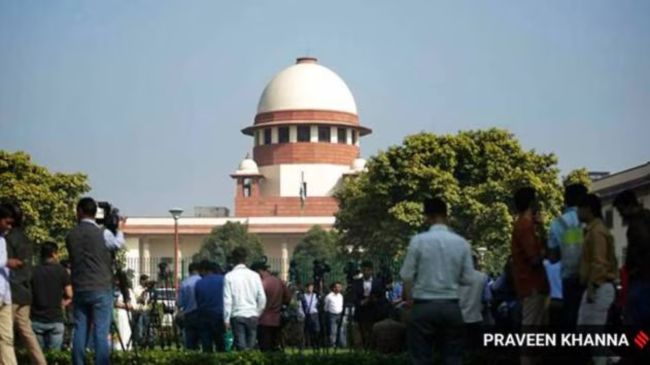Opinion Supreme Court’s comments on obscenity in OTT make us think again: What is obscene?
While regulating content on OTT platforms, the government must ensure that it does not curtail the idea of freedom of art and expression. What may be offensive to some people today may not be so in the future.
 A bench of Justices B R Gavai and A G Masih also issued notice to the Centre and OTT platforms such as Netflix, Amazon Prime, AltBalaji, Ullu Digital, and Mubi, and social media platforms X Corp, Google, Meta Inc, and Apple. (File photo)
A bench of Justices B R Gavai and A G Masih also issued notice to the Centre and OTT platforms such as Netflix, Amazon Prime, AltBalaji, Ullu Digital, and Mubi, and social media platforms X Corp, Google, Meta Inc, and Apple. (File photo) Written by Shashank Maheshwari
“Obscenity only comes in when the mind despises and fears the body, and the body hates and resists the mind.” This quote from D H Lawrence’s book Lady Chatterley’s Lover still haunts the obscenity jurisprudence across the world.
The Supreme Court’s recent observation in a public interest litigation case titled Uday Mahurkar and others v Union of India and others, that there is a requirement to regulate “obscene” content on Over the Top (OTT) and social media platforms, has reignited the debate over the definition of obscenity and the necessity of judicial intervention to curb it down. This and the earlier controversy over Ranveer Allahabadia have made us ask again: Where do we draw the line between free speech and obscenity?
Obscenity in India: A legal history
Historically, India’s approach to obscenity has been deeply influenced by colonial morality. Section 294 of the Bharatiya Nyaya Sanhita (BNS), a successor to Section 292 of the Indian Penal Code, criminalises acts deemed lascivious or appealing to prurient interest. However, what we read as IPC section 292 today (first introduced in 1925) came after India participated in the International Convention for Suppression of Traffic in Obscene Literature in 1923. Similarly, Section 67 of the Information Technology Act penalises the transmission or publication of obscene materials, and section 67A penalises the transmission or publication of sexually explicit content in electronic form. However, both provisions are subject to exceptions provided in section 67B. Furthermore, the Cable Television Network Rules of 1994 prohibit showing any content on cable TV that is obscene (Rule 6(d)) and which shows indecent representation of women (Rule 6(k)).
What is deemed “obscene” has not remained constant. Initially judged through the Victorian-era Hicklin test, to the contemporary Community Standards test laid down in Aveek Sarkar v State of West Bengal (2014), the judiciary has moved toward a more contextual understanding of obscenity. The Supreme Court has also clarified, notably in the College Romance case, that the mere use of profanity does not constitute obscenity unless it arouses sexual thoughts.
OTT platforms and controversies
Online streaming platforms, which were valued at around Rs 500 crore in 2019, have now expanded to an impressive Rs 4000 crore. But, with the growing market, they have also come under the sharp radar of various regulatory authorities. In 2021, the National Commission for Protection of Child Rights (NCPCR) took action against the Netflix series Bombay Begums, accusing it of showing minors engaging in inappropriate and obscene behaviour. Similarly, producer Ekta Kapoor and her mother, Shobha Kapoor, were booked under the POCSO Act for allegedly showing obscene scenes involving minors in shows aired on their OTT platform ALT Balaji. In another case, the NCPCR lodged complaints against the Ullu app, known for streaming adult content, for distributing “obscene and objectionable material”. Under mounting pressure, including from Google, Ullu was forced to scale down its adult content, a sharp reminder that market forces and regulatory threats can together curtail free expression.
In 2023, the Modi government released a draft bill, the Broadcasting Services (Regulation) Bill, 2023, to replace the three-decades-old Cable Television Networks Regulation Act of 1995, for regulating content on such platforms. The draft Broadcasting Bill mandated compliance with a Programme and Advertisement Code for both traditional and OTT broadcasters, with penalties for violating “decency” and “morality” standards. It also required content to be self-classified by theme and audience, with age ratings and parental controls. However, following widespread criticism that the Bill infringed upon freedom of the press and free speech, the government eventually withdrew it. These developments — and the government’s broader push to regulate content — rest heavily on the argument of reasonable restrictions under the Constitution’s Article 19(2), on the grounds of morality and decency. However, we must understand that imposing such restrictions should not evolve into disproportionate censorship.
Can we really define obscenity?
The higher judiciary, through various judgments, has tried to define “obscenity”. But, is it at all possible to define obscenity in deterministic terms? Justice Potter famously remarked in Jacobellis v Ohio (1964): “I shall not today attempt further to define the kinds of material…But I know it when I see it, and the motion picture involved in this case is not that”. Shabana Azmi’s film Fire, released in 1996, faced a ban in India due to its allegedly obscene portrayal of a lesbian relationship. However, society has evolved since then, and the idea of obscenity has also changed. It is now crucial for the government to ensure that while regulating content on OTT platforms, it does not curtail the idea of freedom of art and expression, because what may be offensive to some people today may not be so for the future generation.
The writer teaches at Jindal global law school





